Chateau Haut Brion
a wine every hotelier should know about
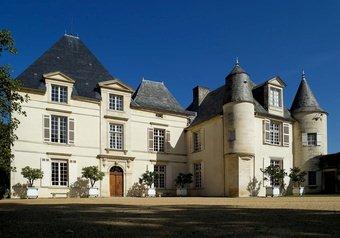
Chateau Haut Brion Graves, Pessac Leognan, Bordeaux wine producer profile, with a history of the property, plus information on their wine making techniques and their terroir, along with wine tasting reviews and links.
Chateau Haut-Brion has one of the longest and most interesting histories of any Bordeaux wine chateau. The property derives its name from an ancient Celtic term “Briga.” Loosely translated, this means a rise or mount in the land. This unique terroir was prized for Bordeaux wine vineyard land 600 years ago!
Documents are available showing that Johanna Faure grew vines at Haut Mont near Haut-Brion. These ancient records arre dated September 6, 1426! This was for a local chapel that was founded in Bordeaux by the Menuts Monks to remember the recently deceased Johan d’Artiguemale.
A little more than a century later, April 23, 1525 to be exact, Jeanne de Bellon, the daughter of the Mayor of Libourne was to be married. Like many wealthy women of the time, she came with dowry. This dowry consisted of Bordeaux wine property from Pessac Leognan called Haut Brion. Once the couple was married, her husband, Jean de Pontac bought the mansion of Haut-Brion from Jean Duhalde in 1533, for the sum of 2,650 Tournois pounds. This was the official birth of one of the most famous Bordeaux wine estates, Château Haut-Brion. 16 years later, in 1549, Jean de Pontac began constructing a new cand much more imposing chateau.
Moving forward about one hundred years, official records for the wine cellar ledger of English king Charles II state, in 1660 and 1661, at least 169 bottles of the wine of Hobriono were poured for royal guests.
The first reference of the wine, which is considered the first official review of any wine was of Chateau Haut Brion. April 10, 1663 Samuel Pepys (The Robert Parker of his day) wrote the following tasting note after tasting the Bordeaux wine at London’s Royal Oak Tavern, “There I drank a sort of French wine called Ho-Bryan that hath a good and most particular taste I never met with.” On that day Haut Brion entered the history books as being the world’s first wine to have a professional review.
Thomas Jefferson,the third President of the United States traveled to Bordeaux in 1787 as America’s French ambassador. Jefferson was received at Chateau Haut Brion on May 25. After his visit, Jefferson wrote, “The soil of Haut-Brion, which I examined in great detail, is made up of sand, in which there is near as much round gravel or small stone and a very little loam like the soils of the Médoc. In the category of red wines,” he wrote, “there are four vineyards of prime quality:
1. Château Margaux, belonging to the Marquis d’Argicourt, who produces around 150 barrels that were sold by contract to a merchant named Jernon.
2. La Tour Ségur, (Chateau Latour ) in Saint-Lambert, belonging to Mister de Miromesnil, who produces 125 barrels.
3. Haut-Brion, two-thirds of which belong to the Count de Fumel who sold the harvest to a merchant called Barton. The other third belongs to the Count of Toulouse; in all, the château produces 75 barrels.
4. Château de la Fite, Chateau Lafite Rothschild) belonging to President Pichard of Bordeaux, which produces 175 barrels”.
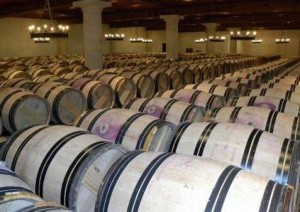
Jefferson, the eventual President of the United States, had already discovered the four best Bordeaux wines of the day. His list of Premiers Grands Crus was same as the list drawn up almost 75 years later with the official 1855 classification.
Haut-Brion sold to Charles-Maurice de Talleyrand-Périgord, Prince of Benevento in 1801. Talleyrand did not stay at Haut-Brion often as was busy with his duties as Minister of Foreign Affairs to Emperor Napoleon I. In 1836, the Bordeaux wine property was sold at auction to a banker from Paris, Joseph-Eugène Larrieu. At this time, the Bordeaux wine of Chateau Haut-Brion wine was widely sold in the United States. New Orleans with its French influence was a popular market for the wine.
A letter dated April 6, 1850 to Joseph-Eugène Larrieu by Mister Loreilhe, a wine merchant, complained the merchant did not receive enough cases of Haut-Brion to satisfy his customers from last year. The letter adds comments that even at that time, the Bordeaux wine of Chateau Haut-Brion was packaged with the greatest of care, “labels and capsules bearing your name, which is also branded onto the cork as well as a glass seal on the bottle’s neck”.
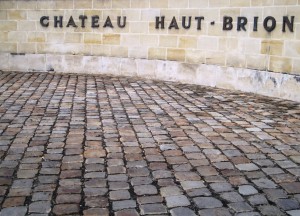
In 1855, Château Haut-Brion was awarded Premier Grand Cru status. Only Lafite, Latour, and Margaux were considered in the same class. Mouton did not become a First Growth until 1973. Amédée Larrieu, son of Joseph-Eugène, took over the management of the property starting in 1859. The property remained in the Larrieu family until 1922.
1935 began a new era for Chateau Haut-Brion. In this period of crisis, the mood was one of astonishment when one of New York’s major financiers, Clarence Dillon, declared his interest in a French vineyard, buying it on the 13th of May 1935. In 1979 at the age of 96, Dillon passed away. He was almost the same age as the founder of Haut Brion, Jean de Pontac. In 1953, his son, C. Douglas Dillon, was appointed ambassador of the United States in Paris during General Eisenhower’s presidency. He went on to become Undersecretary of State for Economic Affairs, then served as Secretary of the Treasury for John F. Kennedy. At the end of his tenure in Paris, his daughter, Joan, remained in France. In 1967, Joan Dillon married His Royal Highness Prince Charles of Luxembourg, Prince of Nassau, Prince of Bourbon-Parme and a direct descendant of Henri IV. In 1975, the Princess, Clarence Dillon’s grand-daughter, succeeded her cousin Seymour Weller at the head of the château.
After the death of Prince Charles of Luxembourg, in 1978 Princess Joan married the Duke de Mouchy. The Duke de Mouchy joined the Management of Domaine Clarence Dillon alongside the Duchess, before retiring in 2003. Today, the continuity and presence of the Dillon family are ensured, for the next generation, by Prince Robert of Luxembourg.
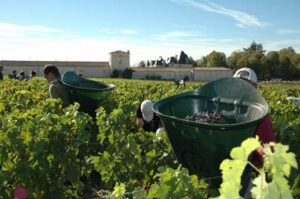
The 48 hectare property is planted on deep gravely soil over clay and sand. With vines averaging 27 years of age, the vineyard is planted to 45.4% Merlot, 43.9. Cabernet Sauvignon, 9.7% Cabernet Franc and 1% Petit Verdot, pruned to the double Guyot method and with a vine density of 10,000 vines per ha. Production averages between 8,000 and 10,000 cases per year.
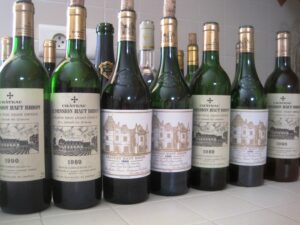
Haut Brion is in a class by itself. There is no other Bordeaux wine like it. The complex aromatics with all the earthy, tar, leather, smoke, truffle, cassis and spice are unique to Haut Brion. This is an incredibly, refined, elegant style of wine, that is never heavy or out of balance, There is a purity of fruit found in this stylish Bordeaux wine that is unique to Haut Brion. Compared to the other First Growths, it will usually be ready to drink at a younger age. But that does not mean it doesn’t age as well. Far from it. In fact, for example well stored bottles from 1928, 1929 and 1945 all offer compelling tasting experiences today. Life is too short not to drink Haut Brion as often as possible.
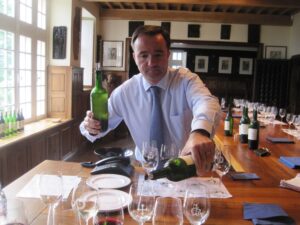
Chateau Haut Brion as Chateau La Mission Haut Brion are currently managed by Jean-Philippe Delmas. Jean-Philippe is the second generation of Delmas to take care of La Mission Haut Brion and the third generation of Delmas to manage Haut Brion, where he followed in the footsteps of his well-known father, Jean-Bernard Delmas.
Additional reading:
www.haut-brion.com/
www.domaineclarencedillon.com/prehome/
Source:
The Wine Cellar Insider

Chateau Haut Brion Graves, Pessac Leognan, Bordeaux wine producer profile, with a history of the property, plus information on their wine making techniques and their terroir, along with wine tasting reviews and links.
Chateau Haut-Brion has one of the longest and most interesting histories of any Bordeaux wine chateau. The property derives its name from an ancient Celtic term “Briga.” Loosely translated, this means a rise or mount in the land. This unique terroir was prized for Bordeaux wine vineyard land 600 years ago!
Documents are available showing that Johanna Faure grew vines at Haut Mont near Haut-Brion. These ancient records arre dated September 6, 1426! This was for a local chapel that was founded in Bordeaux by the Menuts Monks to remember the recently deceased Johan d’Artiguemale.
A little more than a century later, April 23, 1525 to be exact, Jeanne de Bellon, the daughter of the Mayor of Libourne was to be married. Like many wealthy women of the time, she came with dowry. This dowry consisted of Bordeaux wine property from Pessac Leognan called Haut Brion. Once the couple was married, her husband, Jean de Pontac bought the mansion of Haut-Brion from Jean Duhalde in 1533, for the sum of 2,650 Tournois pounds. This was the official birth of one of the most famous Bordeaux wine estates, Château Haut-Brion. 16 years later, in 1549, Jean de Pontac began constructing a new cand much more imposing chateau.
Moving forward about one hundred years, official records for the wine cellar ledger of English king Charles II state, in 1660 and 1661, at least 169 bottles of the wine of Hobriono were poured for royal guests.
The first reference of the wine, which is considered the first official review of any wine was of Chateau Haut Brion. April 10, 1663 Samuel Pepys (The Robert Parker of his day) wrote the following tasting note after tasting the Bordeaux wine at London’s Royal Oak Tavern, “There I drank a sort of French wine called Ho-Bryan that hath a good and most particular taste I never met with.” On that day Haut Brion entered the history books as being the world’s first wine to have a professional review.
Thomas Jefferson,the third President of the United States traveled to Bordeaux in 1787 as America’s French ambassador. Jefferson was received at Chateau Haut Brion on May 25. After his visit, Jefferson wrote, “The soil of Haut-Brion, which I examined in great detail, is made up of sand, in which there is near as much round gravel or small stone and a very little loam like the soils of the Médoc. In the category of red wines,” he wrote, “there are four vineyards of prime quality:
1. Château Margaux, belonging to the Marquis d’Argicourt, who produces around 150 barrels that were sold by contract to a merchant named Jernon.
2. La Tour Ségur, (Chateau Latour ) in Saint-Lambert, belonging to Mister de Miromesnil, who produces 125 barrels.
3. Haut-Brion, two-thirds of which belong to the Count de Fumel who sold the harvest to a merchant called Barton. The other third belongs to the Count of Toulouse; in all, the château produces 75 barrels.
4. Château de la Fite, Chateau Lafite Rothschild) belonging to President Pichard of Bordeaux, which produces 175 barrels”.

Jefferson, the eventual President of the United States, had already discovered the four best Bordeaux wines of the day. His list of Premiers Grands Crus was same as the list drawn up almost 75 years later with the official 1855 classification.
Haut-Brion sold to Charles-Maurice de Talleyrand-Périgord, Prince of Benevento in 1801. Talleyrand did not stay at Haut-Brion often as was busy with his duties as Minister of Foreign Affairs to Emperor Napoleon I. In 1836, the Bordeaux wine property was sold at auction to a banker from Paris, Joseph-Eugène Larrieu. At this time, the Bordeaux wine of Chateau Haut-Brion wine was widely sold in the United States. New Orleans with its French influence was a popular market for the wine.
A letter dated April 6, 1850 to Joseph-Eugène Larrieu by Mister Loreilhe, a wine merchant, complained the merchant did not receive enough cases of Haut-Brion to satisfy his customers from last year. The letter adds comments that even at that time, the Bordeaux wine of Chateau Haut-Brion was packaged with the greatest of care, “labels and capsules bearing your name, which is also branded onto the cork as well as a glass seal on the bottle’s neck”.

In 1855, Château Haut-Brion was awarded Premier Grand Cru status. Only Lafite, Latour, and Margaux were considered in the same class. Mouton did not become a First Growth until 1973. Amédée Larrieu, son of Joseph-Eugène, took over the management of the property starting in 1859. The property remained in the Larrieu family until 1922.
1935 began a new era for Chateau Haut-Brion. In this period of crisis, the mood was one of astonishment when one of New York’s major financiers, Clarence Dillon, declared his interest in a French vineyard, buying it on the 13th of May 1935. In 1979 at the age of 96, Dillon passed away. He was almost the same age as the founder of Haut Brion, Jean de Pontac. In 1953, his son, C. Douglas Dillon, was appointed ambassador of the United States in Paris during General Eisenhower’s presidency. He went on to become Undersecretary of State for Economic Affairs, then served as Secretary of the Treasury for John F. Kennedy. At the end of his tenure in Paris, his daughter, Joan, remained in France. In 1967, Joan Dillon married His Royal Highness Prince Charles of Luxembourg, Prince of Nassau, Prince of Bourbon-Parme and a direct descendant of Henri IV. In 1975, the Princess, Clarence Dillon’s grand-daughter, succeeded her cousin Seymour Weller at the head of the château.
After the death of Prince Charles of Luxembourg, in 1978 Princess Joan married the Duke de Mouchy. The Duke de Mouchy joined the Management of Domaine Clarence Dillon alongside the Duchess, before retiring in 2003. Today, the continuity and presence of the Dillon family are ensured, for the next generation, by Prince Robert of Luxembourg.

The 48 hectare property is planted on deep gravely soil over clay and sand. With vines averaging 27 years of age, the vineyard is planted to 45.4% Merlot, 43.9. Cabernet Sauvignon, 9.7% Cabernet Franc and 1% Petit Verdot, pruned to the double Guyot method and with a vine density of 10,000 vines per ha. Production averages between 8,000 and 10,000 cases per year.

Haut Brion is in a class by itself. There is no other Bordeaux wine like it. The complex aromatics with all the earthy, tar, leather, smoke, truffle, cassis and spice are unique to Haut Brion. This is an incredibly, refined, elegant style of wine, that is never heavy or out of balance, There is a purity of fruit found in this stylish Bordeaux wine that is unique to Haut Brion. Compared to the other First Growths, it will usually be ready to drink at a younger age. But that does not mean it doesn’t age as well. Far from it. In fact, for example well stored bottles from 1928, 1929 and 1945 all offer compelling tasting experiences today. Life is too short not to drink Haut Brion as often as possible.

Chateau Haut Brion as Chateau La Mission Haut Brion are currently managed by Jean-Philippe Delmas. Jean-Philippe is the second generation of Delmas to take care of La Mission Haut Brion and the third generation of Delmas to manage Haut Brion, where he followed in the footsteps of his well-known father, Jean-Bernard Delmas.
Additional reading:
www.haut-brion.com/
www.domaineclarencedillon.com/prehome/
Source:
The Wine Cellar Insider




Comments